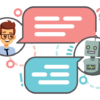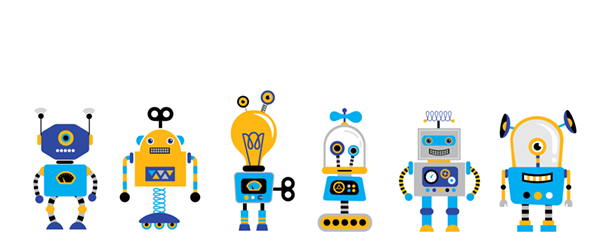Chatbots are all the rage nowadays. Today we’re going behind the buzzword to understand what they are, how different industries are using them, and why they are so popular so you can decide if they are right for your organization.
Chatbots have received a lot of attention in the last year as sophisticated conversion tools, feeding into a broader excitement surrounding the adoption of AI and automation. The enthusiasm can be measured by the introduction of such online publications as Chatbots Life, Chatbots Magazine, and Chatbots.org. Drift, the conversational marketing platform that is leading the industry, has experienced record-breaking growth.

There is something to the buzz: chatbots are really neat. A company could hire or outsource employees to take on instant messaging with their customers, or they could tailor conversational algorithms in chatbots to meet the needs of their customers. They might not have that special human touch, but chatbots are consistent and can be constantly tweaked to improve interactions over time. The most sophisticated chatbots actually tweak themselves, using machine learning principles (more on this later).
We’ve said before that technology adoption in companies should be similar to shifting gears in a manual car. It’s about timing: don’t shift too early because you want to go fast (and don’t shift too late either). The reality is chatbots are not appropriate for every company, all the time. Today we’re going to take a deep dive through the buzz to more fully understand the place of chatbots in the current digital landscape.
Chatbot basics
So what exactly is a chatbot? Simply put, a chatbot is a conversational marketing tool that automates either textual or voice conversations with end-users. Instead of instant messaging with a support agent, a customer can engage with a chatbot to receive instantaneous replies based on user inputs. Sophisticated algorithms combined with user data ensure the outputs are as personalized as possible – the goal is to resemble genuine human interaction, only more efficient.
Chatbots have existed for a while. Conceptually, chatbots were introduced by Alan Turing in his famous 1950 article “Computing Machinery and Intelligence”, where he proposed the Turing test as a criterion for artificial intelligence. The test depended on whether a computer program could reliably impersonate a human being in real-time, written conversations. Mainstream chatbots of today are far from passing a Turing test, but they are still increasing in sophistication.

In 1966, ELIZA, the mother of modern chatbots, was introduced as the first computer program that could attempt the Turing test. In 1994, Michael Mauldin (the creator of Julia, the first Verbot) coined the term “Chatterbot” to describe these programs.

In 2016, chatbots finally received mass appeal when Facebook allowed developers to build chatbots on the Messenger platform. In the first year since the introduction of chatbots on the platform, 100,000 bots were created as businesses on Facebook were eager to leverage the new technology.
Chatbot Adoption
The 100,000 bot figure is just the one-year milestone. By mid-2018 there were over 300,000 chatbots on Facebook. It’s no surprise either: basic chatbots take about ten minutes to set up on the social network.

According to Google Trends data, interest in chatbots has surged dramatically in the last few years. Big tech companies like Google, Amazon, Facebook and Microsoft view chatbots as the next big thing and are all developing their own iterations of the technology. Microsoft CEO Satya Nadella even went on to say that “bots are the new apps.”
The future outlook of chatbots is overwhelmingly optimistic: Gartner research predicts that by 2020, 85% of customer interactions will be handled without a support agent, and by 2021, 50% of enterprises will spend more on chatbots than mobile apps. Nadella has a point!
Chatbots by Industry
Many industries are profiting from chatbots. Some of the top industries benefiting from chatbots are retail, insurance, healthcare, hospitality, finance, and even government.
Retail
Retail and e-commerce are the industries most people think about when considering chatbot use. Juniper Research estimates that by 2023, over 70% of chatbots accessed will be retail-based. Chatbots in retail are leveraged to help users find products or suggest products a user may enjoy, taking into account colour, size, and product category. Retail brands like H&M, Tommy Hilfiger, and Whole Foods have successfully introduced chatbots. According to DigitasLBi, 22% of consumers want recommendations from chatbots for products from retail stores.
Insurance
Another industry that is expected to benefit from chatbots is insurance. A clear use case for chatbots on insurance company websites is to get a quick quote for insurance premiums or to file a claim. Insurance companies have a reputation for using confusing jargon and many processes are tedious. A conversational approach may be less time-consuming and labour-intensive than a multi-step wizard that is currently the norm. According to a Global Trends Study, insurance invests an average of $124 million per company in chatbot technology. Chatbots help to cut down administrative costs, allowing insurance providers to lower premiums and be more competitive. In 2016, insurance company Lemonade’s chatbot named Jim settled a claim within 3 seconds.
Healthcare
Adoption of chatbots is occurring across the healthcare industry, improving the experience of patients. Chatbots will answer questions about emergency room stays, post-discharge, and follow-up appointments. Greg Johnsen, CEO of LifeLink, an emergency department chatbot provider, estimates that chatbots can save medium to large emergency departments between $2 million and $5 million annually due to reduced overhead costs.
Hospitality
Chatbots are shaking up the hospitality industry by providing a new way for hotels to tailor promotions and for guests to easily make bookings. They are capable of responding to thousands of inquiries at once.
Finance
Automated customer experiences in banking and finance are expected to save the industry $7.3 billion by 2023, according to Juniper Research. The equivalent time saved by banks is approximately 862 millions hours. Banking institutions are often at the forefront of chatbot development, such as Bank of America’s Erica, which debuted successfully in 2018 and currently reaches 6 million customers.
Government
State, local, and federal governments worldwide are beginning to leverage chatbots to better engage their citizens. Many government IT centres still take thousands of calls each work over the phone, and in one state, 45-50% of these calls were for a password reset. Automating certain processes through chatbots allows governments to more effectively allocate resources and keep costs low. Popular government chatbots include the Department of Homeland Security’s “Emma”, named for an American poet and the Government of Mississippi’s State chatbot “Missi”.
Why are chatbots so popular?
Cost Savings and ROI

There is strong evidence that chatbot adoption leads to significant cost savings for enterprises. According to IBM research, businesses spend $1.3 trillion on 265 billion customer service calls each year. Chatbots, IBM estimates, can successfully answer up to 80% of routine questions. Costs are far lower as a chatbot can address thousands of queries at once, whereas humans are limited to one query at a time. Further, chatbots ensure that the human support team is not overloaded, because common requests are addressed and filtered before human intervention. The efficiencies and cost savings can be monumental.
Of course, chatbots also mean that every lead coming through the website at any time of day are attended to instantly. Timely responses help prevent unnecessarily lost revenue.
Customer Experience
Conversation comes naturally to humans, hence the shift towards conversational marketing. Customers aren’t so naive as to confuse a chatbot with a real person – chatbots still have a long way to go before that even approaches reality. The main draw with chatbots is an appeal to the impatient consumer: providing them with the information they need on command. Human beings drink coffee, chat with coworkers, smoke cigarettes, and eat sandwiches. Chatbots, on the other hand, are always listening for user inputs and can calculate and spit out the most appropriate response in under one second. According to 2017 Hubspot research, 57% of consumers are interested in chatbots for their instantaneity.

In a paper published in the Proceedings of the 4th International Conference on Internet Science, authors Petter Bae Brandtzaeg and Asbjørn Følstad found the following:
- Of the 68% of respondents who used chatbots for productivity, 42% cited ease of use, speed, and convenience as their reasons for using chatbots.
- 41% use chatbots to obtain help and information faster, often instead of performing a search.
- Interestingly, 5% said they preferred to interact with a chatbot than a person because of reduced waiting time, and another 5% preferred chatbots to humans because they felt they were less intimidating and weren’t worried about feeling stupid asking important questions.
This all sounds great, so what’s the catch?
The problem with chatbots
Mainstream chatbots, in their current incarnation, are not even close to genuine artificial intelligence. If anything, they serve as supplementary navigational aids on websites more than anything else. An extremely rudimentary input/output engine that conceals the basic functionality using correct sentence structure.
In many ways, chatbots are often just a bandaid solution to poor user experience and user interface design. In other words, if your company is considering a chatbot to assist users in navigating the website, the first thing to consider is whether the UX/UI needs to be improved – not whether an AI assistant is required to help steer visitors through the noise. For enterprises, consider consulting a digital agency like OPIN to help assess the need for a chatbot as part of your overall digital strategy.
This doesn’t mean that all chatbots are a wasted investment – in fact, many industries are creating incredible efficiencies using the technology (as explained above). However, it’s best to begin from first principles and ensure that conversational UI is not pushing actual UI to the wayside.

Another thing to note is that chatbots help scale existing communications, but don’t necessarily encourage it communication in the first place. The companies that are experiencing the best returns on investment with chatbot adoption are those that are already inundated with inbound requests through web forms or phone calls. Chatbots have a place here because they are relieving existing pressure on support and sales personnel. If there is little or no pressure to begin with, it is probably not worth the investment.
Chatbots depend on masses of existing data and transcripts to generate the intelligence necessary to identify customer intent accurately. If this data does not exist, and chatbot adoption is based on best guesses, it is not the right time to roll out chatbots. Furthermore, if your organization is unwilling to commit the resources to constantly monitoring and tweaking bots, the disconnect between brand and consumer will only grow larger. In spite of AI hype, chatbots are simply not appropriate for every organization.
Another thing to watch out for is a disconnect between hype around a new technology and the actual value it produces for customers. The limitations of chatbot automation are made clear in an article from The Information, that stated that only 30% of requests could be fulfilled by chatbots without intervention from human agents. Yes, chatbot technology has come a long way, but a lot of bots still possess the intellect of a gnat.
The final problem with chatbots that should be addressed is the danger of a push-based communication model. This is the same problem faced by Microsoft’s Clippy the Paperclip, a rudimentary automated assistant that didn’t fail because the technology was poor, but because it popped up at all the wrong times and was rather annoying. Millennials, in particular, have little tolerance for intrusive forms of communication from brands. A brand’s reputation takes years to build and only a handful of negative experiences with annoying bots to destroy.
How to plan your chatbot strategy
It is important that there is both a strong rationale and accompanying strategy behind chatbot adoption. The most important thing is to ensure that the bot is built on a powerful platform that can effectively manage the data requests from thousands of site visitors. The platform I recommend for this purpose, above all others, is the open source Drupal content management system. Popular among enterprises for its scalability and flexibility, the latest version of Drupal is API-firstwith a powerful Chatbot API. Drupal 8.7 was built with digital ecosystems and interconnectivity in mind, making it the perfect platform for conversational marketing.
The next most important pillar of an enterprise chatbot strategy is ensuring accountability measures are in place. Determine what key performance indicators will be used to measure success, the frequency with which tweaks will be made, and who will be responsible for making them. There should also be sufficient data to begin with that will give the chatbot its “intelligence”.
One final thought: Under no circumstances should a company attempt to pass their chatbot off as a real human being. Not only is this a violation of trust and a potential irritant to the customer, but it is an attempt to enter the Uncanny Valley, which is firmly in “creepy” territory. Besides, a lot of customers actually like the “cute robot” aesthetic. Embrace it!

Closing thoughts
In spite of some of their current shortcomings, chatbots are getting smarter every day. Improvements in Natural Language Processing are helping shift the chatbot industry from command-driven towards more intelligent, conversationally driven bots that are more capable of determining context and intent.
We can automate a lot of our processes across teams, but at the end of the day, it’s humans – not robots – that are running companies. It’s important to make the right call about technology, and to ignore the hype. There are a lot of statistics (including those cited in this piece) that make outrageously optimistic claims about chatbots, and some that are overwhelmingly negative. Determine your KPIs and first principles, and stick to those.
Launching your own chatbot is only a small part of your organization’s larger digital strategy. A functional chatbot can help you meet your marketing goals, but only on a flawless website. To help organizations navigate their digital projects, we have created a guide to planning your enterprise website project. In the guide, we dive into the top considerations and pitfalls for organizations launching a new website, well beyond the chatbot. Download your copy right here.
Thanks for reading. If you enjoyed this piece, feel free to subscribe to OPIN’s newsletter for more content like this each week!


